This question is being updated every time I act on someone's suggestion here. Unfortunately though, non of the minor housekeeping suggestions helped enough, so the problem remains.
In the nutshell:
- I have a viewController (secondVC) with a tableView in it (secondTableView).
- Within that tableview, at the very top, I am trying to have a tableHeaderView (with orange background as shown on the attached image).
- Inside of the tableHeaderView I am trying to nest two labels one on top of the other (labelOne on top of labelTwo).
- labelOne is static. I just says "LIST" and remains perpetually unchanged.
- labelTwo is dynamic. It is going to change. It is going to occupy as many lines as needed and the tableHeaderView height should adjust to accommodate and contain both labelOne (LIST) and whatever ends up in labelTwo (long text)
Right now though, as you can see from the picture, labelOne disappeared altogether and labelTwo has weird layout. Something is wrong with constraints I guess. Please help me fix the constraints right.
import UIKit
class SecondVC: UIViewController, UITableViewDelegate, UITableViewDataSource {
@IBOutlet weak var secondTableView: UITableView!
var stuff = [("Some other stuff 1"),("Some other stuff 2"),("Some other stuff 3")]
var insertionText: String = ""
override func viewDidLoad() {
super.viewDidLoad()
secondTableView.delegate = self
secondTableView.dataSource = self
let tableHeader = UIView()
secondTableView.tableHeaderView = tableHeader
tableHeader.backgroundColor = .systemOrange
tableHeader.translatesAutoresizingMaskIntoConstraints = false
let size = tableHeader.systemLayoutSizeFitting(UIView.layoutFittingCompressedSize)
let height = size.height
let width = size.width
tableHeader.frame = CGRectMake(0, 0, width, height)
let labelOne = UILabel(frame: tableHeader.bounds)
labelOne.text = "USER:"
labelOne.numberOfLines = 0
labelOne.lineBreakMode = .byWordWrapping
labelOne.textAlignment = .center
labelOne.translatesAutoresizingMaskIntoConstraints = false
let labelTwo = UILabel(frame: tableHeader.bounds)
labelTwo.translatesAutoresizingMaskIntoConstraints = false
labelTwo.text = "Inherited text here: \(insertionText)"
labelTwo.numberOfLines = 0
labelTwo.lineBreakMode = .byWordWrapping
labelTwo.textAlignment = .center
labelTwo.translatesAutoresizingMaskIntoConstraints = false
tableHeader.addSubview(labelOne)
tableHeader.addSubview(labelTwo)
labelOne.topAnchor.constraint(
equalTo: tableHeader.layoutMarginsGuide.topAnchor,
constant: 11).isActive = true
labelOne.leadingAnchor.constraint(
equalTo: tableHeader.layoutMarginsGuide.leadingAnchor,
constant: 20).isActive = true
labelOne.trailingAnchor.constraint(
equalTo: tableHeader.layoutMarginsGuide.trailingAnchor,
constant: -20).isActive = true
labelTwo.topAnchor.constraint(
equalTo: labelOne.layoutMarginsGuide.bottomAnchor,
constant: 0).isActive = true
labelTwo.leadingAnchor.constraint(
equalTo: tableHeader.leadingAnchor,
constant: 20).isActive = true
labelTwo.trailingAnchor.constraint(
equalTo: tableHeader.trailingAnchor,
constant: -20).isActive = true
labelTwo.bottomAnchor.constraint(
equalTo: tableHeader.bottomAnchor,
constant: -11).isActive = true }
override func viewDidLayoutSubviews() {
super.viewDidLayoutSubviews()
if let tableHeader = secondTableView.tableHeaderView {
let height = tableHeader.systemLayoutSizeFitting(UIView.layoutFittingCompressedSize).height
var headerFrame = tableHeader.frame
if height != headerFrame.size.height {
headerFrame.size.height = height
tableHeader.frame = headerFrame
secondTableView.tableHeaderView = tableHeader } } }
func tableView(_ tableView: UITableView, numberOfRowsInSection section: Int) -> Int {
stuff.count }
func tableView(_ tableView: UITableView, cellForRowAt indexPath: IndexPath) -> UITableViewCell {
let cell = secondTableView.dequeueReusableCell(withIdentifier: "SecondTVCell", for: indexPath) as! SecondTVCell
cell.someOtherStuffLabel.text = stuff[indexPath.row]
return cell } }



